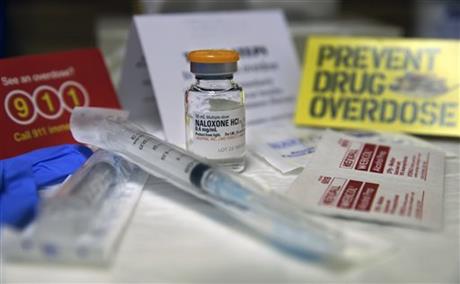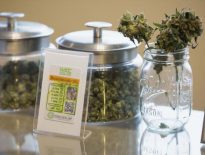CAMDEN, N.J. (AP) — As deaths from heroin and powerful painkillers skyrocket nationwide, governments and clinics are working to put a drug that can reverse an opiate overdose into the hands of more paramedics, police officers and the people advocates say are the most critical group — people who abuse drugs, and their friends and families.

Supporters say the opportunity to save potentially thousands of lives outweighs any fears by critics that the promise of a nearby antidote would only encourage drug abuse.
At least 17 states and the District of Columbia allow naloxone — commonly known by the brand name Narcan — to be distributed to the public, said Jeffrey Levi, executive director of Trust for America’s Health, a national nonprofit that focuses on preventive health care. And at least 10 of those states allow for third parties, such as a family member or friend of an intravenous drug user, to be prescribed it.
Among them is New Jersey, which passed a law last year that allows members of the public to carry naloxone — administered through a nasal spray or injection into a muscle — after getting training.
About 20 people, most of them related to overdose victims or people who currently abuse heroin, crowded into a clinic last weekend in Camden, a drug-plagued city across the Delaware River from Philadelphia, to learn about the antidote. Jane Stiuv, whose daughter survived a heroin overdose in 2011, listened as a nurse described the signs of an overdose and when to administer naloxone.
Stiuv, who found her daughter slumped over the side of a bathtub with a needle in her arm hours after her release from prison, said she wanted to learn how to reverse an overdose should it happen again. Each attendee received a kit containing two syringes, a small vial of naloxone, alcohol swabs and a face shield for rescue breathing.
I was a little shaky. It brings me back to the times she overdosed, Stiuv said of the training. But it makes me feel better that it can help her and do something about overdose prevention.
Naloxone is regarded within the medical community as highly effective when used properly. A study conducted during a state-supported pilot of naloxone distribution and overdose education in Massachusetts showed it was 98 percent effective in attempts to rescue a person who overdosed.
Police in Quincy, Mass., have been carrying naloxone nasal spray since 2010 and said in July 2013 that they used naloxone 179 times, reversing 170 of those overdoses — a 95 percent success rate.
According to the White House Office of National Drug Control Policy, the number of overdose deaths involving prescription drugs increased 21 percent from 2006 to 2010; the number of overdose deaths involving heroin increased 45 percent.
Bills are pending in at least seven states to increase access to naloxone. In Tennessee and Utah, doctors would be allowed to prescribe it, and civil liability for those who administer it would be dropped. A Wisconsin bill seeks to broaden access to naloxone and, as New Jersey also does, provide legal immunity to drug users reporting an overdose.
Marty Walsh, the new mayor of Boston, this month called for all first responders to carry naloxone. Police in Indianapolis, where heroin overdose deaths have doubled since 2011, have started a pilot program to have officers carry the drug. In Ocean County, N.J., police are being trained in how to use it.
The White House drug policy office is also urging all first responders to have naloxone on hand. In 2012, the Food and Drug Administration held hearings on making naloxone available over the counter, but it has not yet done so.
Naloxone is available by prescription in the United Kingdom, but an advisory council has called for over-the-counter distribution. Prescription take-home programs are in place in Australia, Canada, Estonia and Russia. Norway plans to distribute nasal spray kits to drug users in its two largest cities.
But not everyone is sold on the idea of making it more widely available.
In Maine, where heroin overdoses increased fourfold from 2011 to 2012, Gov. Paul LePage opposes a bill that would allow health care professionals to prescribe it and allow more emergency responders to carry the drug.
LePage, who wants to add 14 new drug enforcement agents in the state, cites concerns that it would raise Medicaid costs. He also has said the drug provides a false sense of security that abusers are somehow safe from overdose if they have a prescription nearby.
This bill would make it easier for those who have substance abuse problems to push themselves to the edge, or beyond, LePage wrote in a letter last year explaining his veto of a similar bill designed to expand access to naloxone. Offering temporary relief without medical or treatment oversight will not combat drug use.
Dr. Marcus Romanello, the chief of the emergency room at Fort Hamilton Hospital in Hamilton, Ohio, said he believes police should carry naloxone but is leery of giving it to the public.
There is no disputing, however, that it works, he said.
They are pulled back from the jaws of death, as we say, by the Narcan, he said.
An overdose of opiates essentially makes the body forget to breathe. Naloxone works by blocking the brain receptors that opiates latch onto and helping the body remember to take in air. The antidote’s effects wear off in about a half hour, and multiple doses may be needed.
The drug’s backers say it’s crucial to train relatives or friends of addicts because the person overdosing is likely sick or unconscious and unable to self-administer the antidote. It also must be given within a certain window; most overdoses occur within a half-hour to three hours after injecting too much of a drug.
Naloxone wouldn’t, therefore, have helped actor Philip Seymour Hoffman, who died of an apparent heroin overdose this month in his New York apartment and is believed to have been alone as he took drugs; he was already dead when discovered.
At the New Jersey workshop on Saturday, nurse Babette Richter described the signs of an overdose. Observers should watch and listen for raspy breathing and a blue face, signaling a loss of oxygen.
Keep a close eye on people who nod off after using, and try to wake them, Richter instructed. If they do not rouse, place them a floor or other hard surface, give rescue breaths every 10 seconds or so, and administer naloxone.
The most important thing, Richter said, is to call 911 and wait with the person who has overdosed — and to remember that in New Jersey, the caller can’t be charged with a crime.
This is buying us time, Richter said. It’s not a cure.
___
Associated Press writers Alanna Durkin in Augusta, Maine, and Dan Sewell in Cincinnati contributed to this report. Follow Zezima athttp://twitter.com/katiezez





